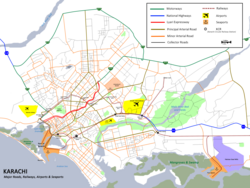This article needs additional citations for verification .(August 2020) |
| Qamar House | |
|---|---|
 | |
| Former names | Qamar House |
| Alternative names | EFU Building |
| General information | |
| Architectural style | Art Deco [1] |
| Location | 16/2 G.K.8 Ghulam Hussain Kassim Quarters, M. A. Jinnah Road, Karachi, Sindh |
| Country | Pakistan |
| Coordinates | 24°50′52″N66°59′39″E / 24.8477°N 66.9942°E |
| Elevation | 29 ft (8.8 m) above msl |
| Current tenants | Eastern Federal Union (EFU Life) Insurance Company |
| Construction started | 1946 |
| Completed | 1955 |
| Inaugurated | 1957 [1] |
| Cost | Rs 2.4M in 1957 |
| Landlord | Qamardin & Other’s 1945-2002; EFU-2002 onward |
| Height | 129 ft (39 m) |
| Dimensions | |
| Diameter | Trapezoidal |
| Other dimensions | 150×300 ft (46×91 m) |
| Technical details | |
| Structural system | RCC Frame in filled masonry |
| Floor count | 12 |
| Floor area | 268,056 sq ft (24,903.2 m2) |
| Design and construction | |
| Architect(s) | Qamardin Mahomed Hashwani (QMH) |
| Structural engineer | A Mevawalla |
| Civil engineer | Ahmedali Mahomed Hashwani (AMH) |
| Quantity surveyor | Qamardin Hashwani with Qamardin Valliani |
| Awards and prizes | Sindh Government Recognition 15 April 2011 National Heritage Monument, EFU House (Qamar House) [2] |
| Other information | |
| Parking | Open plot (cos) 125 sq yd (105 m2) |
| Website | |
| efuinsurance | |
| References | |
| Qamardin Jaffer Valliani: Procurement for building Qamar House & facilities maintenance management till 2002 | |
Qamar House, now known as the EFU Building, is a building in central Karachi, Pakistan, designed in the Art Deco architectural style by Qamardin Mahomed Hashwani in 1945 and built on Muhammad Ali Jinnah Road between 1946 and 1955 by Qamardin & Co. It was the tallest building in Karachi until the construction of the Habib Bank Plaza building by the AKFED (Aga Khan Fund for Economic Development) in 1968.
